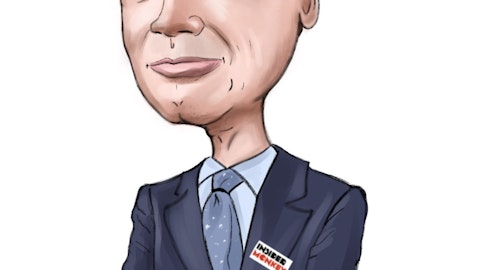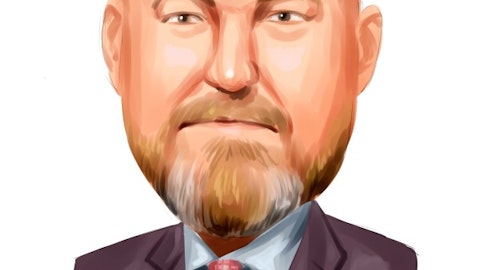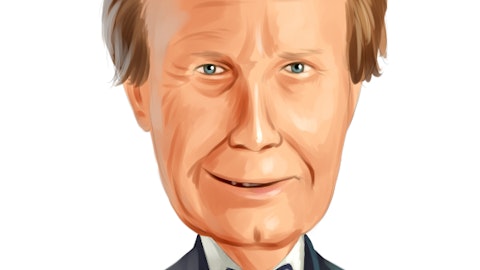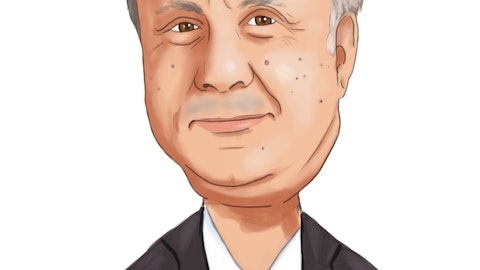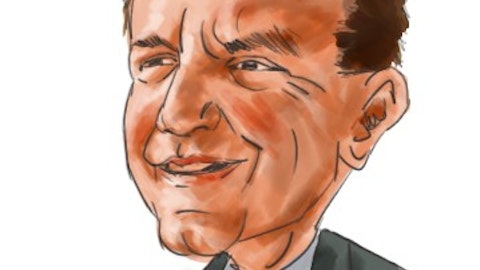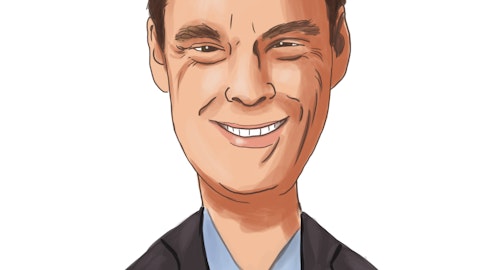Jim Clemmer: Thanks.
Operator: Our next question is from the line of Bill Plovanic with Canaccord Genuity. Please proceed with your question.
Bill Plovanic: Great, thanks. Good morning and thanks for taking my questions. I don’t think you addressed with the litigation with Bard. I was just – what are the next steps? How is that going to impact the P&L and cash flow? And any timing for any events or news that we should expect?
Steve Trowbridge: Hey, Bill, this is Steve. I can take that one. So we have put out the 8-K earlier during the quarter indicating the decision on the litigation. As we said at the time and as we’ve talked about at conferences then, this is a long ongoing war. We don’t see this as the end, and it’s going to continue. So it’s really business as usual, it’s not anything that’s going to be materially impacting how we’re running our business. It’s been ongoing for a long time. So when you’re asking about the P&L implications, for the most part, they’ve kind of been baked in there and so I wouldn’t see any material deviations going forward from what you’ve seen in the past. As we’ve said, timing, there’s appeals on our case, there’s appeals on other cases that are very similar.
They may come up within the course of our Q3. For the other case, we’re still waiting for some scheduling on the other questions that have to be answered in our case. So still ongoing. As any material things happen, we’ll certainly be telling you. But for the most part, it’s not something that’s impacting how we run our business day to day.
Bill Plovanic: Okay. Thank you for that. And then just on the Auryon that was pretty strong in the quarter. You mentioned that you launched the hydrophilic coating. How much of the quarter was sell-through versus maybe initial purchases on the limited market release?
Jim Clemmer: So Bill, not a lot of limited – not a lot of purchases on the limited market release. Really, that was just confirming we’ll use the LMR process forward, confirm that the product meets our customers’ expectations. So – and now we’re ramping up our production shifting from the non-coated to the new hydrophilic process, that’s why I mentioned the second half of this fiscal year when we make that flip over. So it’s really just – we’re meeting demand, Bill. Really strong demand still for the product just by how it performs. And we’re pleased with the customer contacts we have, hearing stories every day of how much confidence they gain when they use it. We know there’ll be a lot of data presentations during the course of this calendar year where physicians will present data on how well Auryon works and treats safely and effectively in the anatomy. So continued confidence in the platform, Bill, and it’s really just normal organic growth.
Bill Plovanic: Okay. And then last question for me if I may. Just you mentioned that the backlog went from $7 million to $5 million. Is it – should we expect that to go down further? Or are you kind of now at a steady state kind of normal business? How should we think about that as you move forward? That’s it for me. Thanks.
Jim Clemmer: Good question, Bill. So yes, we’re going to continue to work to get it down to what we would call a normal operating back order level, which is far below that $5 million level here. We’re pleased with our teams and how they’ve done it. We’ve got better participation and our labor forces now stabilized, our labor forces and our operations teams here in the U.S. And as you’re aware, we opened up our Costa Rican operation about a year ago. So now we’ve got a calendar event, we’re cycling back and we’re expanding capacity there and efficiencies are growing. So we’re pleased there. We’ll get the back order backlog back to a normal operating level. And even from there, Bill, we’re even doing things like speaking to our customers who had some products in order for a long time, double checking that they want them and they need it and it’s clear.
So we’re going to clean it up. The pandemic has thrown a lot of curveballs at everybody in our industry and we work hard with our customers to make sure we’re serving them to the best of our ability. We learned a lot here and our teams responded and we’ll get that backlog down, hopefully close to normal, by the end of this fiscal year.
Bill Plovanic: And just for clarification purposes, normal would be the remaining $5 million would be cleared out?
Jim Clemmer: No, we always have a backlog, Bill. We try to target about half -day sales is a target we do. So if you look at that, you call that you know, three quarters $1 million in that range is what we kind of target as a normal backlog, back order. So we’ll probably – you never get it to zero. We have a complex diverse portfolio, as you know, with over 1,000 SKUs. So we get into that half day sales and a target that we feel comfortable with our customers.
Bill Plovanic: Thank you.
Operator: The next question is from the line of Steve Lichtman with Oppenheimer. Please proceed with your questions.
Steve Lichtman: Thank you. Good morning, guys. Clemmer if I could follow up on small vessel DVT. So I guess a couple of things. Should we assume that 14 French AlphaVac is not going to come to market now and the shift that’s been completed toward Auryon? Or is that perhaps just pushed later? And what else do you need to do regulatory wise or data wise on Auryon to go after small vessel DVT with that platform?
Jim Clemmer: Hi, Steve. Thanks for the question. So a couple of things. You’re right, so we’ve suspended really the development efforts on our 14 French AlphaVac because we’ve just seen such a kind of demand and interest from our physician partners who’ve used Auryon that have really told us the power of how it works, how our 355-nanometer wavelength delivers energy and protect the vessel wall. The reason why it’s safe and effective in the arterial parts of the body, we believe now can offer the same benefits in the venous structure. So we’re now shifting that development for that small vessel DVT. Whereas we thought the 14 French AlphaVac would have been our best option a couple of years ago, now the learnings that we’ve gained and the conversations with our partners made us believe that Auryon can really fill that gap better because of how it can deliver the energy, also the aspiration capabilities which are mechanical here with Auryon.
So we’ll get back to you with a little further time lines. But we think, as we said earlier, we’ve got a potential plan to launch technology by the end of calendar 2024 which also obviously includes the regulatory pathway clearances that we need.
Steve Lichtman: Okay. And we should expect in the interim some additional data around the efficacy of Auryon in small vessel DVT, so we’ll get some visibility on that in the coming periods?
